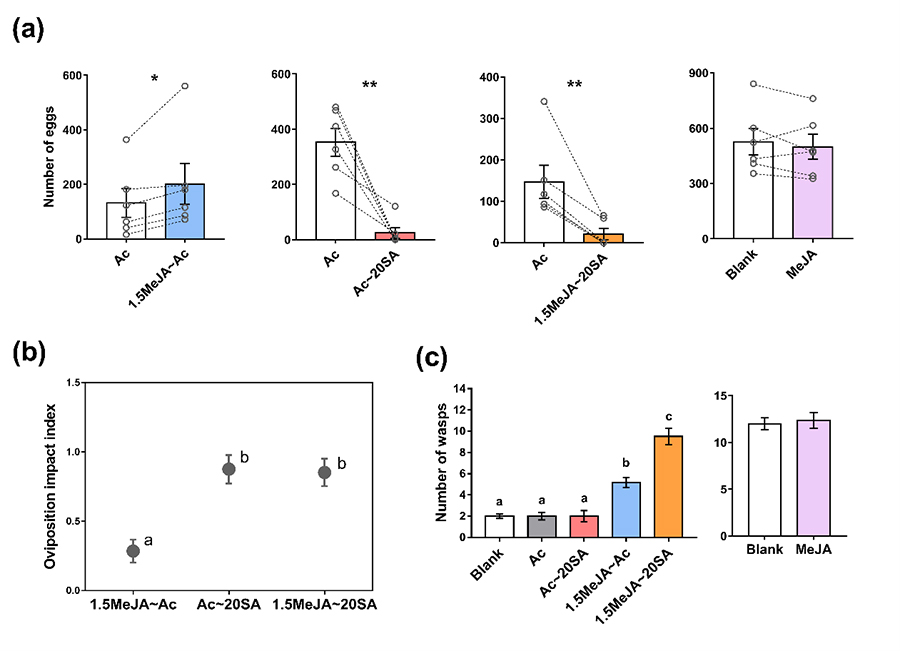
Effects of interaction between jasmonic acid and salicylic acid signaling pathways in tea plant revealed by TRI
Source: Tea Research Institute, Chinese Academy of Agricultural Sciences
Recently, researchers from the Tea Research Institute of the Chinese Academy of Agricultural Sciences (TRI CAAS) revealed the JA-SA interactive effects in tea plant.
The jasmonic acid (JA) and salicylic acid (SA) pathways are the main phytohormones signaling pathways related to plant resistance. Two pathways interacted during the signaling transduction, which further affects their mediated anti-herbivore functions. Currently, the JA-SA interaction was mainly studied on gene transcript and protein levels in the upstream part, and was commonly regarded as reciprocally antagonistic. Only a few studies focused on the changes in downstream metabolites and the ecological outcome of the interaction.
Tea (Camellia sinensis) is a perennial woody plant species and an important beverage crop worldwide. Using an established theoretical model, researchers investigated how tea plant volatiles induced by exogenous elicitors of JA and SA pathways are affected by the sequence of the elicitor application, the elicitor identity, and the applied concentrations. Researchers also studied the effects of the volatiles mediated by the JA–SA synergistic interaction on the behaviors of a tea leaf-chewing herbivore (Ectropis grisescens) and its parasitic wasp (Apanteles sp.).

Figure. Effect of the jasmonic acid (JA)–salicylic acid (SA) reciprocal synergism on the behaviors of Ectropis grisescens moths and Apanteles sp. wasps.
Results showed that the JA and SA pathway interactions were almost always reciprocally synergistic when the two pathways were elicited at different times, except at high JA elicitor concentrations. However, the JA pathway antagonized the SA pathway when they were elicited simultaneously. The elicitor identity affected the degree of the JA–SA interaction. The volatiles induced by the JA pathway in the JA–SA reciprocal synergism treatments included up to 11 additional compounds and the total amount of volatiles was up to 7.9-fold higher. Similarly, the amount of emitted volatiles induced by the SA pathway in the reciprocal synergism treatments increased by up to 4.2-fold. Compared with the volatiles induced by either pathway, the enriched volatiles induced by the JA–SA reciprocal synergism resulted in stronger resistance to E. grisescens, including similarly repelled E. grisescens and more strongly attracted Apanteles sp.
The study highlights the importance of considering the timing and dosage of elicitor applications when studying the plant JA–SA interaction. Moreover, the reciprocal synergism between the JA and SA pathways allows the plant to initiate multifarious responses that lead to stronger biotic stress resistance compared with that induced by eliciting a single pathway.
The above results have been published in Horticulture Research in an essay entitled “Enhanced volatile emissions and anti-herbivore functions mediated by the synergism between jasmonic acid and salicylic acid pathways in tea plants”. PhD candidate Jiao Long from TRI CAAS is the first author. Professor Chen Zongmao and Professor Cai Xiaoming from TRI CAAS are the corresponding authors. The work was supported by the Modern Agricultural Industry Technology System (CARS-19), the National Key Research & Development Plan (2016YFD0200900), and the Key Research and Development Program of Zhejiang Province (2019C02033).
Link to the paper:
https://doi.org/10.1093/hr/uhac144
by Jiao Long (jiaolong@tricaas.com)